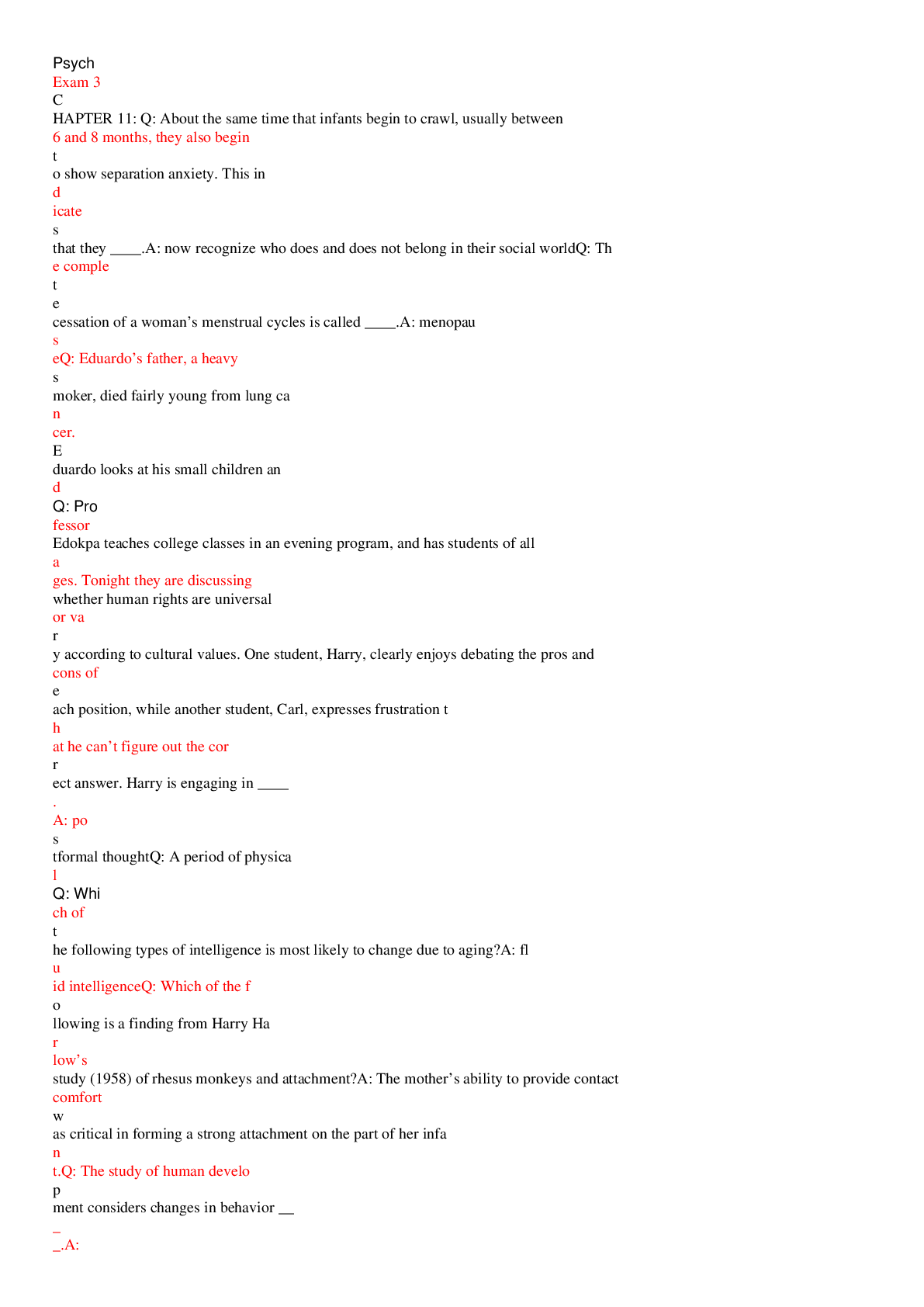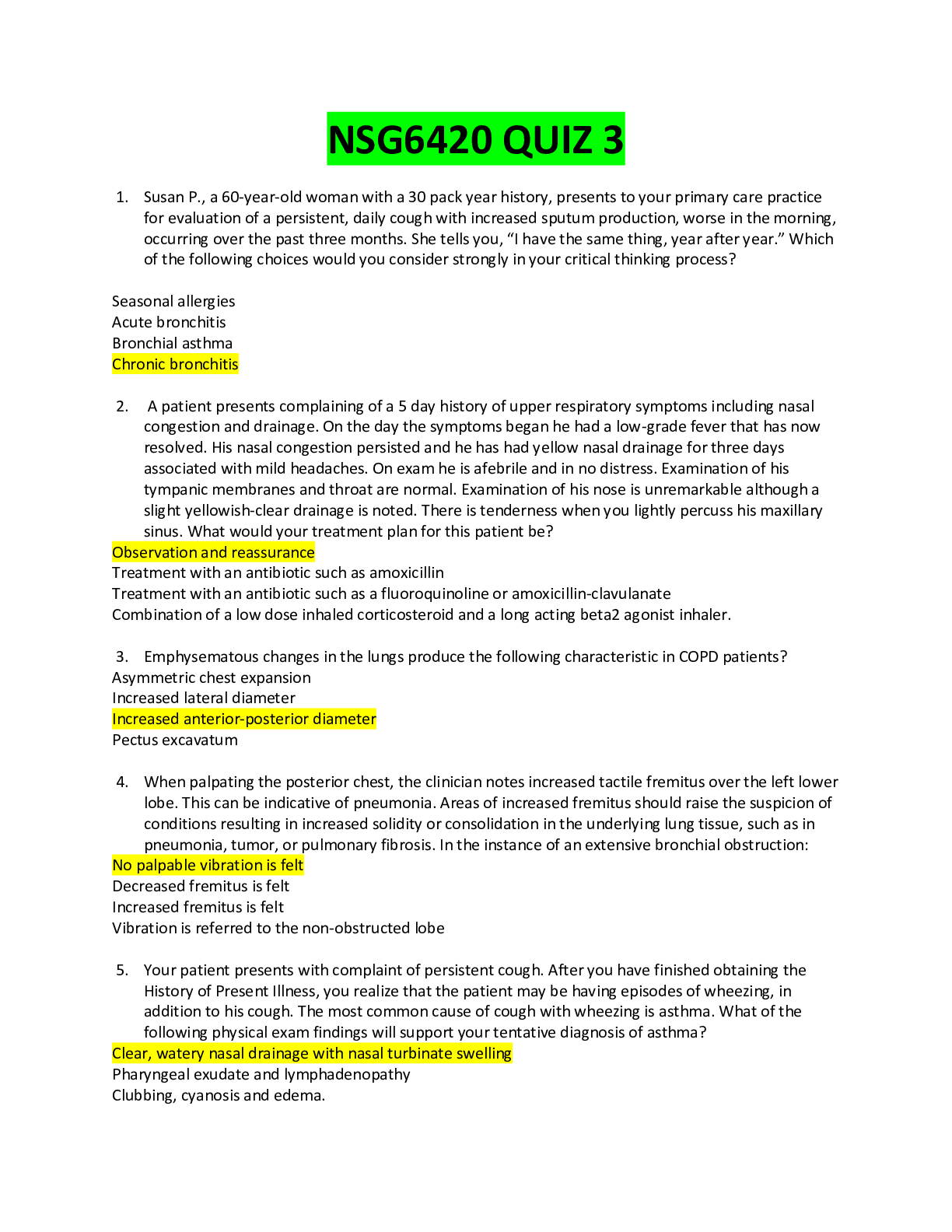Psychology > EXAM > PSYC3350 |PSYC 3350 Cultural Psychology Chapter 14 TESTBANK Questions With Complete And Latest Answe (All)
PSYC3350 |PSYC 3350 Cultural Psychology Chapter 14 TESTBANK Questions With Complete And Latest Answers (Updated) download To Score 100%
Document Content and Description Below
PSYC 3350 Cultural Psychology - Chapter 14 – TESTBANK 1. According to the James-Lange theory of emotions, which of the following qualifies as an emotion in a scenario where Ed meets his boss fo... r the first time? a) the assumptions that Ed makes about past experiences with his previous bosses b) how Ed interprets his profuse perspiration upon seeing his boss c) the profuse perspiration that Ed experiences upon seeing his boss d) how Ed appraises an event, but only if the event is relevant to other people. e) The excitement that Ed experienced upon seeing his boss. 2. Based on the results from Schacter and Singer’s experiment on the two-factor theory of emotion, under which of the following situations would Darryl feel the most euphoria? a) when he is with someone who is trying to getting him to feel giddy b) when he eats a sugar pill that he was told would make him feel aroused c) when he ingests a stimulant that he was told would make him feel aroused d) when he ingests a stimulant that he was told would not affect his arousal e) when he ingests some stimulant that he was told would make him feel less aroused 3. According to research on facial expressions across cultures, if Dixon, who’s an American, makes facial expressions for the basic emotions a) other cultures generally would not be able to recognize his expressions. b) only cultures that have much contact with Americans would be able to recognize his expressions. c) only his expressions for happiness and sadness would be recognized by other cultures, but not his expressions for anger and disgust. d) his expressions would be recognized above chance in virtually all cultures. e) None of these statements is true. 4. Which of the following is not one of Ekman’s basic emotions? a) pride b) disgust c) surprise d) fear e) All of these are basic emotions. 5. Shawn displays something that can be characterized as being a ritualized display of excitement. What does this imply? a) Shawn had to practice a lot to be able to make this display. b) Shawn didn’t need to learn to make this display. c) Shawn dampened his expression of excitement so as to not upset those around him. d) People from other cultures likely can’t recognize that he is excited. e) This display is one of the expressions identified by Ekman and his colleagues. 6. What can the basic emotions best be characterized as? a) nonuniversals b) at least existential universals c) at least functional universals d) ritualized displays e) display rules 7. The tendency for Indians to sometimes bite their tongues reflects a) feelings of sadness b) a basic emotion c) a reflexive emotional expression d) a ritualized display e) None of these choices is correct. 8. In one experiment investigating anger responses, European-Canadians and Chinese- Canadians differed in a) the intensity of their facial expressions, but not in their emotional experiences. b) that the Chinese-Canadians did not show any physiological anger response, whereas the European-Canadians did. c) the rate at which their physiological response returned to baseline. d) that Chinese-Canadians showed more of an extreme physiological response, although they reported being less angry than European-Canadians. e) that Chinese-Canadians’ physiological responses fluctuated much more than did the European-Canadians’ physiological responses, indicating uncertainty in the situation. 9. Different languages from around the world a) all have words that correspond to the basic emotions, but often not for the nonbasic emotions. b) sometimes do not have emotion words that correspond with each of the basic emotions. c) may have words for the same emotions as in English, but do not necessarily experience those emotions similarly to English speakers. d) all have hundreds of words to express different emotions. e) all have a word for disgust. 10. Comparisons of Surinamese and Turkish immigrants to Holland with mainstream Dutch citizens of Holland reveal that a) Surinamese and Turkish immigrants expressed more relational concerns than Dutch citizens. b) Surinamese and Turkish immigrants display their emotions more intensely than Dutch citizens. c) Surinamese and Turkish immigrants are less happy than Dutch citizens. d) Surinamese and Turkish immigrants who were more acculturated had more similar emotional experiences to Dutch citizens than did those immigrants who were less acculturated. e) None of these statements is true. 11. Japanese and American emotional experiences have been shown to differ in that a) Japanese experience more interpersonally engaged emotions than Americans. b) Japanese experience a broader range of emotions than Americans. c) Japanese feel better than Americans when they are experiencing interpersonally engaged emotions. d) Americans experience both interpersonally engaged and interpersonally disengaged emotions more than Japanese. e) Japanese report feeling more intense positive feelings than Americans. 12. Derp has lived a privileged life and has always had very high subjective well-being. He is ready to change – he wants to be unhappy and have low subjective well-being. Based on the dynamic social impact theory, which region of the United States should Derp move to if he wants to become less happy and have low subjective well-being? a) East South Central b) West North Central c) West South Central d) the Mountain West e) New England 13. The relation between money and happiness is that a) there is no relation between money and happiness. b) people who are richer than their neighbors are happier, but absolute levels of money do not predict happiness. c) money does predict happiness consistently across all levels of income. d) money is positively related to happiness in poor countries, but negatively related to happiness in rich countries. e) None of these statements is true. 14. Which of the following situations would predict greater subjective well-being for Alex, who is from a collectivistic culture? a) Alex’s parents are doing very well in their business. b) Alex feels a great deal of excitement. c) Alex has a vast network of friends. d) Alex abides by his culture’s norms. e) Alex receives a prize from his school’s prize draw. 15. Research reveals that, in contrast to Westerners, the most desired kinds of emotional states among East Asians are a) low arousal positive states. b) feelings of group pride. c) feelings of interpersonal connection. d) future positive emotional states. e) purely positive affective states. 16. Schacter and Singer’s study of emotions found that a) people sense clear physiological indicators of anger but not of euphoria. b) people attend to situational cues to interpret their bodily sensations. c) people who took epinephrine felt the strongest emotions. d) people with independent views of self attend more to their bodily sensations than those with interdependent views of self. e) people have an accurate understanding about the link between their physiological states and their emotions. 17. Jordan received a botox injection for the area around her eyes, meaning that the muscles around her eyes would be paralyzed and look emotionless for a period of time, while the rest of her face can still move. Before the paralyzing effect of the botox has worn off, she has dinner with an American friend and a Japanese friend. Jordan smiled throughout the night, indicating that she had a good time. Will Jordan’s friends believe her smile? a) Both friends will likely believe Jordan’s smile. b) Neither friend will likely believe Jordan’s smile. c) Both will be unsure of whether to believe Jordan’s smile. d) The American friend likely will not believe Jordan’s smile, but the Japanese friend likely will. e) The American friend likely will believe Jordan’s smile, but the Japanese friend likely will not. 18. Joon-ha, a Korean child, is trying to facially express that he is upset. Which of the following people would be best at identifying that Joon-ha is upset? a) Person A, who is American b) Person B, who is also feeling upset c) Person C, who is able to ignore contextual cues d) Person D, who is Korean e) Person E, who is expressing sadness 19. Based on Kitayama and colleagues’ study of emotions among Japanese and Americans, one would expect that, between Jun, who’s Japanese, and Jerry, who’s American, a) Jun would feel more happiness than Jerry. b) Jun would feel more respect than Jerry. c) Jun would feel more anger than Jerry. d) Jun would feel more extreme emotions than Jerry. e) None of these statements is true. 20. Two friends from two collectivistic cultures, Jorge (Latin American) and Sayako (Japanese), are visiting club booths at school to decide what clubs to join. Based on research regarding preferences for emotions, which of the following scenario is likeliest to happen? a) Both Jorge and Sayako will choose a Zen meditation club that promotes serenity and calmness. b) Jorge will choose a Zen meditation club that promotes serenity and calmness, and Sayako will choose a rollerblading club that endorses rollerblading at a leisurely pace. c) Jorge will choose a choir that features a lot of energetic and exciting music, and Sayako will choose a Buddhist reading club that features a lot of calming books. d) Jorge will choose an action movie club that features a lot of fast-paced action movies, and Sayako will choose a club that teaches its members to self-criticize and feel bad about themselves. e) Both Jorge and Sayako will choose a high-tempo Salsa dance class that promotes excitement and exhilaration. 21. Don is from an individualistic culture, and Juan is from a collectivistic culture. According to a study by Suh and colleagues, which of the following scenarios regarding subjective well-being is to be expected? a) Having more money makes Don happier than it makes Juan. b) Experiencing more positive affect makes Don happier than it makes Juan. c) Experiencing less negative affect makes Don happier than it makes Juan. d) Having more extreme emotional experiences makes Don happier than it makes Juan. e) Having more harmonious interpersonal relations makes Don happier than it makes Juan. 22. Davina was walking on the street when she happened to glance into a flower store. When she saw a particular flower through the window, she noticed that her heart rate sped up. She decided that her increased heart rate meant that she liked the flower, so she bought the flower. A two-factor theorist would ______ with her conclusion because ______. a) disagree; emotions cannot be determined from interpreting psychological reactions b) disagree; she lacks the experience to determine what her psychological reactions mean c) agree; if increased heart rate is indicative of liking, then her conclusion was valid d) agree; flowers generally lead one to have positive feelings about them e) agree; the flower appeared to be the only source of influence that would have affected her heart rate 23. An expression that is considered a ritualized display is best categorized as a(n) a) functional universal. b) existential universal. c) nonuniversal. d) accessibility universal. e) human universal. 24. The facial feedback hypothesis most closely approximates what theoretical perspective? a) Ekman’s basic emotions b) James-Lange theory of emotions c) two-factor theory of emotions d) interdependent self-construal e) holistic thinking style 25. Based on research about the different roles and functions of happiness across cultures, how can one categorize the assumption that people necessarily want to be happy? a) It is an accessibility universal. b) It is a naïve pursuit. c) It is a nonuniversal. d) It is a functional universal. e) It is an existential universal. 26. Just for fun, Mary decided to tape the corners of her mouth so that she will appear to be smiling for the duration of that day. According to the facial feedback hypothesis, which of the following emotions is Mary most likely to experience as a result? a) happiness b) sadness c) anger d) disgust e) surprise 27. Kartika abides by the idea that people should have emotional “smoothness.” This means that she a) feels no emotions. b) transitions easily from one emotion to another. c) has emotional highs and lows. d) tries to not have strong displays of emotions. e) thinks that people should consistently feel positive emotions. 28. Which of the following is an example of someone defining emotions using the James-Lange theory of emotions? a) Ryan thinks he is in love with Cheryl because she makes him happy every time he sees her. b) Ryan thinks he is happy because it is one of the basic emotions. c) Ryan thinks he feels sadness because his long-time pet had just passed away. d) Ryan thinks he feels excitement because his heart was racing after having held his breath for a minute while under water in the pool. e) Ryan thinks he feels fearful of sharks because his heart was racing after he encountered a shark during his dive, and he knew that the shark was dangerous. 29. Mototeru is a Japanese teenager who reports feeling very positive emotions. According to research by Kitayama and colleagues on emotions associated with happiness, what other emotions is Mototeru likely also experiencing for him to feel such positive emotions? a) respect b) shame c) positive interpersonally disengaged emotions d) negative interpersonally engaged emotions e) happiness 30. Mike is an Asian-Canadian who just got shoved in the mall by another person. Compared to a European-Canadian who experiences the same thing, Mike is a) more likely to dampen his physiological response to this event. b) more likely to chase after the person who shoved him. c) less likely to understand what happened to him. d) less likely to understand why the man would have shoved him. e) more likely to raise the issue with security guards on duty. [Show More]
Last updated: 2 years ago
Preview 1 out of 8 pages
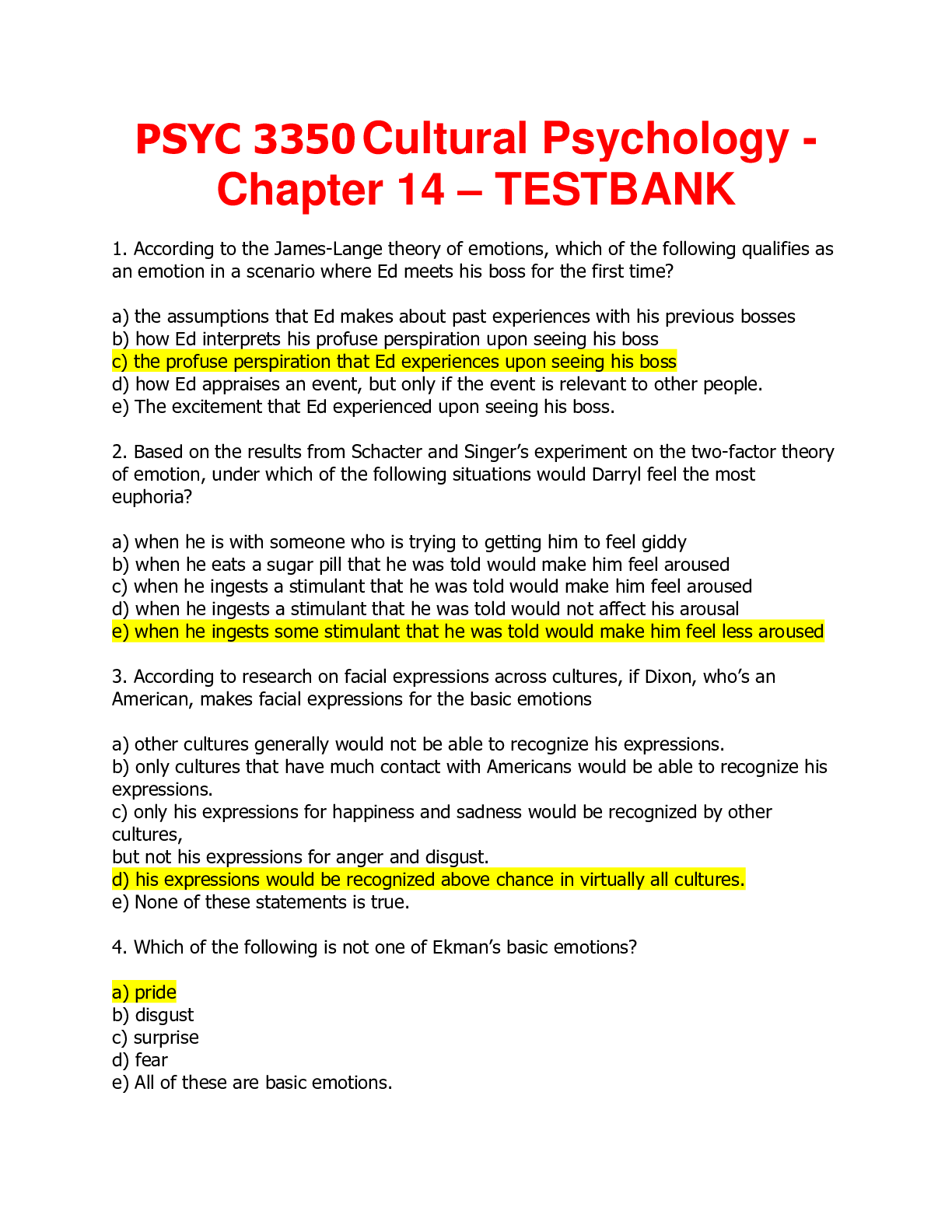
Buy this document to get the full access instantly
Instant Download Access after purchase
Buy NowInstant download
We Accept:

Reviews( 0 )
$18.00
Can't find what you want? Try our AI powered Search
Document information
Connected school, study & course
About the document
Uploaded On
Aug 15, 2020
Number of pages
8
Written in
Additional information
This document has been written for:
Uploaded
Aug 15, 2020
Downloads
0
Views
120

.png)





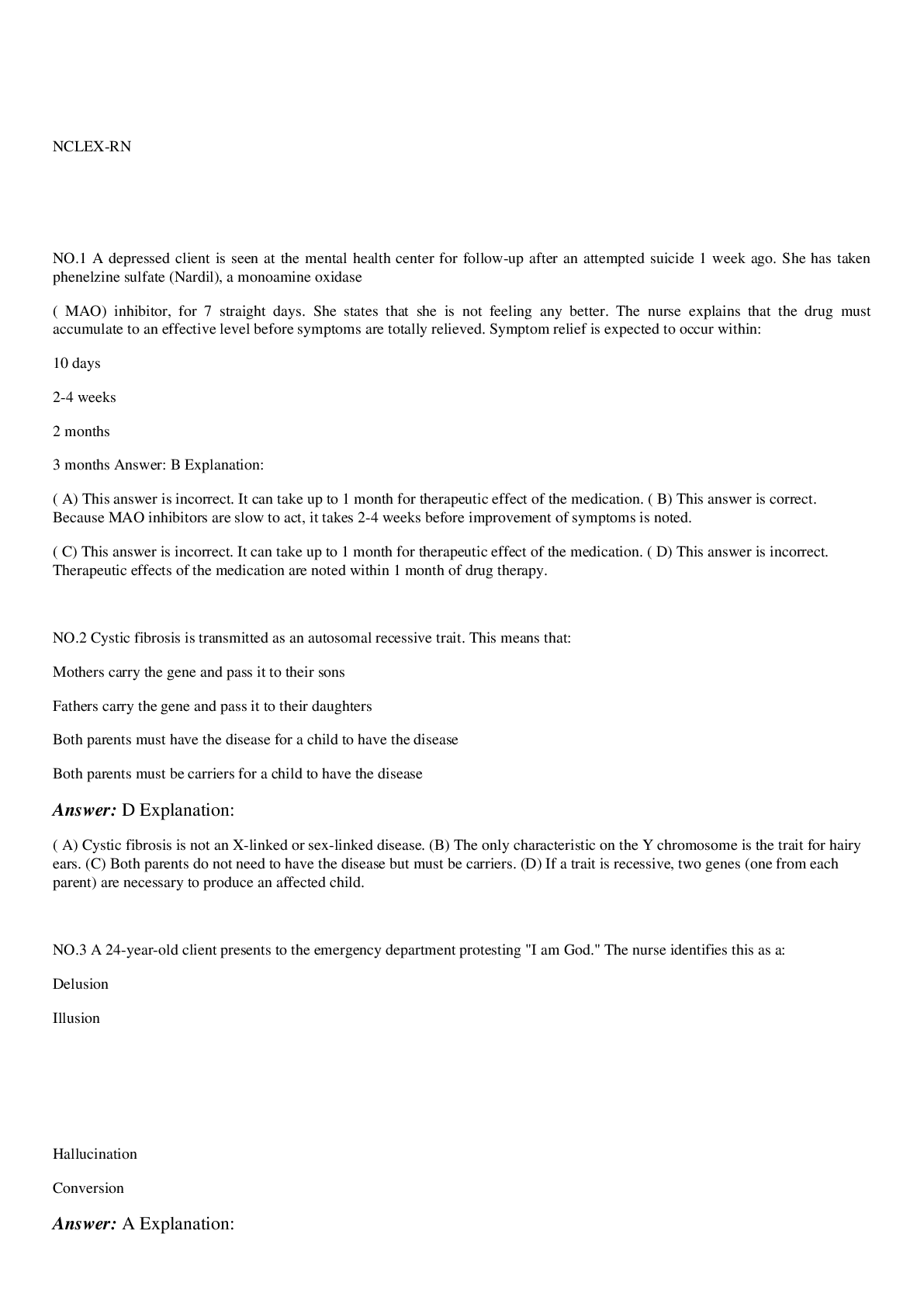
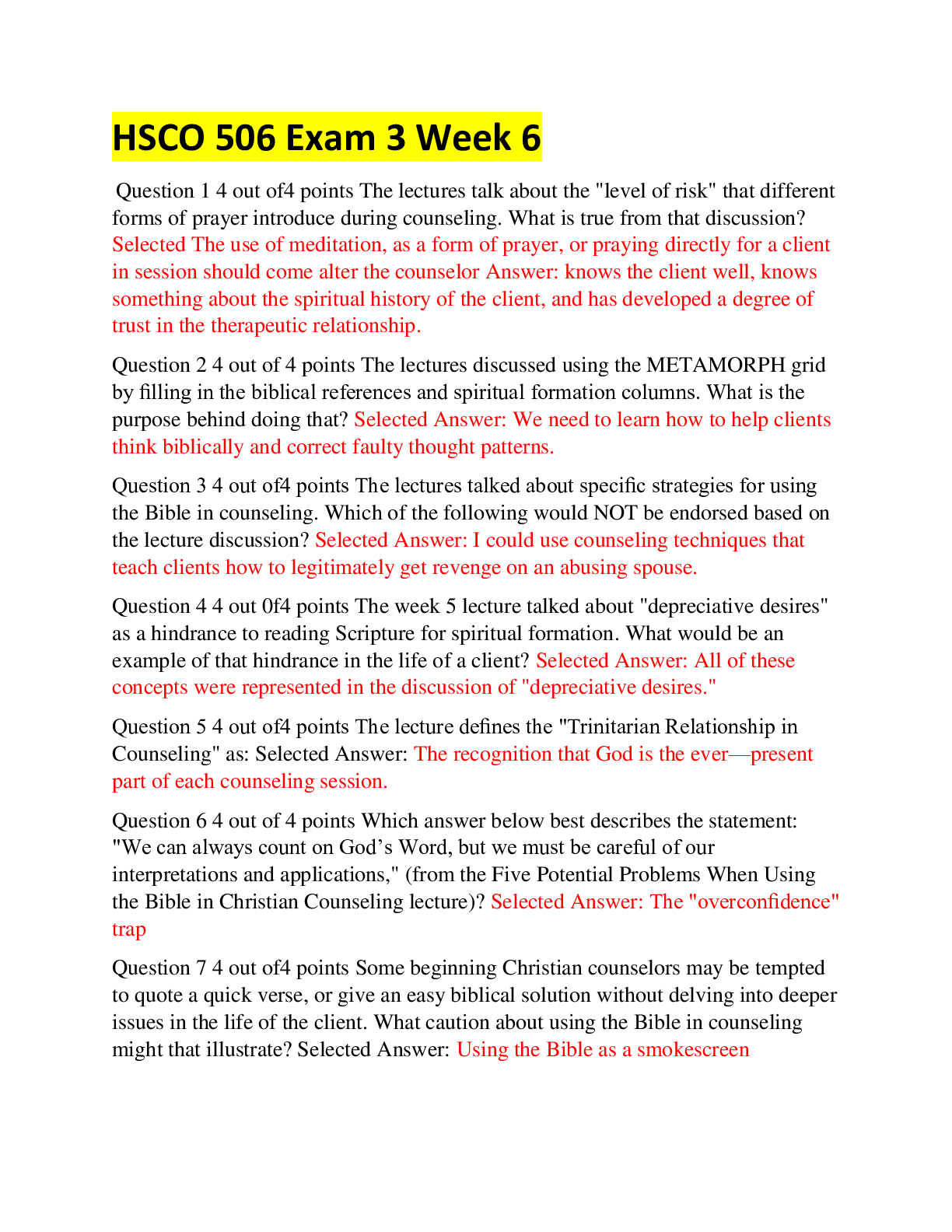

.png)




